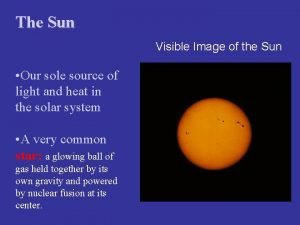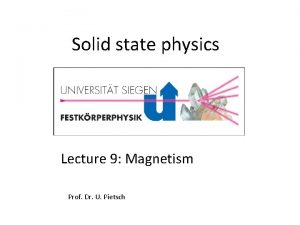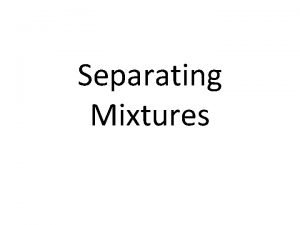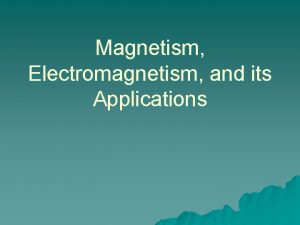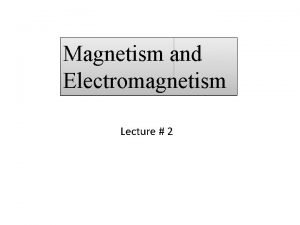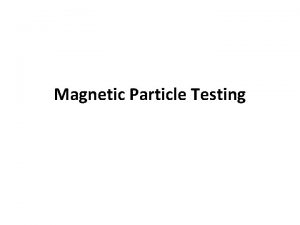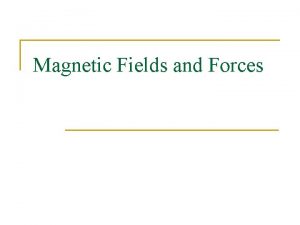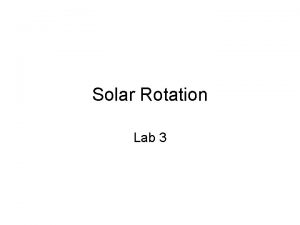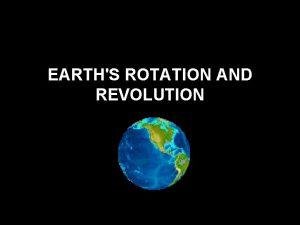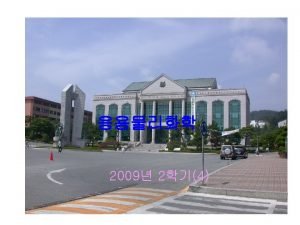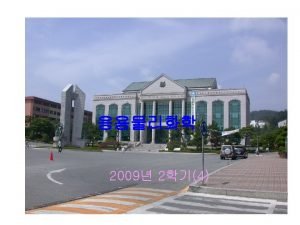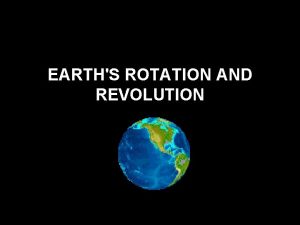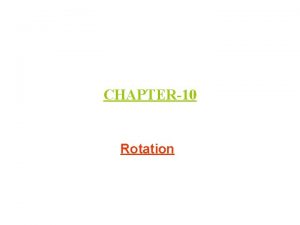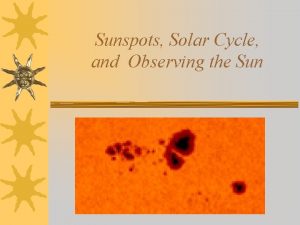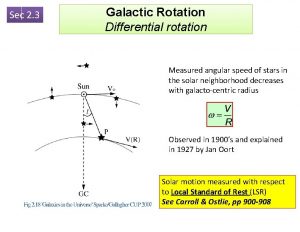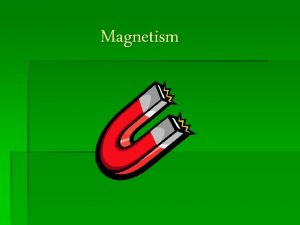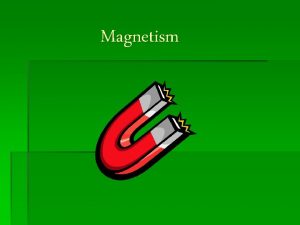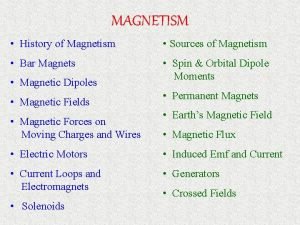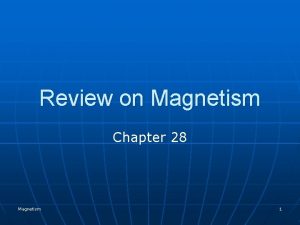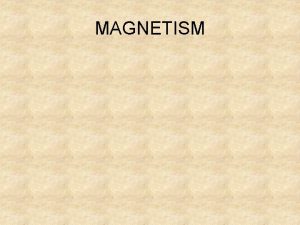Solar Magnetism Differential Rotation Sunspots Solar Cycle Guest
























- Slides: 24

Solar Magnetism Differential Rotation, Sunspots, Solar Cycle Guest lecture: Dr. Jeffrey Morgenthaler Jan 30, 2006

Neutrino Summary • Principle of CONSERVATION OF ENERGY led to proposal of neutrino by Wolfgang Pauli • Neutrino flux from sun measured by several experiments (in units of SNU) fell short from solar model expectations (solar neutrino problem) • Solar model proves reliable for many thing • Led to proposal of MSW (neutrino oscillations) • Solar astronomy helped particle physics

Review Helioseismology • Review effect of sound speed on waves – Vacuum cleaner analogy – Car hitting puddle on freeway analogy – Waves propagate faster towards center of Sun • Refraction (bending) depends on wavelength – Bigger wheels on vacuum cleaner – Better treads on tires • Particular wavelengths reinforce constructively – http: //gong. nso. edu/gallery/im ages/harmonics/pmode. mpg

Solar Oscillations

Global Oscillations Network Group (GONG) • Allows continuous viewing of Sun

Helioseismology probes solar interior

GONG results • Blow-up of GONG results (axes reversed) shows fantastic detail • Gives accurate depth of convective zone – 0. 713 of solar radius • Measures differential rotation – Rotation speed as a function of depth

Differential rotation—pre GONG

Differential rotation seen by GONG • GONG has been operating for more than 10 years • Pattern of rotation vs. depth in 1995 was almost the same now as it was in 2005 • What is going on?

Solar and Heliospheric Observatory • Orbits Sun every 365 days • Pulled equally by Sun’s and Earth’s gravity – Lagrange point L 1 • Has 12 scientific instruments, including 3 for Helioseismology

SOHO Michelson Doppler Imager (MDI) • Measures rotation speeds (red faster, blue slower than average) • Shows plasma flow under equator • Hint of flow towards poles

SOHO GOLF (Global Oscillations at Low Frequencies) • Measured sound speed compared to theory • Something funny going on at base of convection zone

Brief Review

Sunspots • First recorded observations by Chinese astronomers around 28 BC • First detailed study by Galileo and other astronomers around 1610 • Profound implications for Aristotelian cosmology

Sunspot structure • Recall granules • Recall black body radiation – Sunspot darker because it is cooler • Umbra darkest part – Size of 1 -10 earths • Penumbra is transition zone • Fibrils are penumbral intrusions into umbra • Plages (beaches) light regions beyond penumbra Photo Credit (T. Rimmele (NSO), M. Hanna (NOAO)/AURA/NSF)

Sunspot behavior • Tend to come in pairs • Come and go in a few days to a month • Were first evidence of differential rotation – But move around themselves (mostly north/south) • Movie from SOHO SOI instrument

Sunspot number variation • Sunspot number varies with an 11 -year period – SOLAR CYCLE • Period discovered by amateur astronomer – Heinrich Schwabe of Dessau, Germany, ~1840 – 17 years of observations • Almost certainly related to period observed helioseimologically • Sunspots start each solar cycle appearing 30 deg above and below equator • As cycle progresses, spots appear more toward equator


Sunspots are related to magnetic field • First proposed by George Ellery Hale around 1900 – Looked at sun a different way (narrow-band filter) • Discovered chromosphere, above photosphere – Saw light only emitted by Hydrogen atoms • Sunspots looked like “cyclonic whirls” • Hypothesized electrons in whirls would generate a magnetic field – Devised an experiment to measure magnetic field using the Zeeman effect • Found magnetic field • Does that mean electrons generated magnetic field? • Magnetic field is buried in Sun and “bubbles up”

Big Bear Solar Observatory Halpha images http: //www. bbso. njit. edu/images. html

Zeeman Effect • Quantum mechanical effect • Allows measurement of magnetic field – Strength is distance between spectral lines – Polarization is direction of magnetic field • Sun spot field is 10004000 gauss – Earth at surface is 0. 3 gauss http: //csep 10. phys. utk. edu/astr 162/lect/light/zeeman-split. html

Babcock Model for Sunspot formation • See fig 5 -13 in text • Differential rotation distorts N/S field so it starts to run E/W • Explains why sunspots come in pairs – Magnetic field pokes out of sun and back in – Like a thread stitching through fabric • Explains generally why sunspots start at 30 degrees N and S latitude • Explains why sunspots get “squeezed” into lower latitudes • Generally explains why sunspot activity dies down after spots reach equator – Magnetic field cancels itself out • Explains why sunspots show up with reverse polarity the next time around • Details of where magnetic field is formed might be wrong in Babcock model – field seems to be deeper than he thought

Arch Prominences • H-alpha emission traces out magnetic field lines • Out one sunspot, in another NSO/Sac Peak/NOAO

Sunspot, Differential Rotation, Magnetic field Summary • Sunspots observed on an 11 -year cycle – SOLAR CYCLE • Sunspots linked to magnetic field – Observed using Zeeman effect • Differential rotation “winds up” magnetic field – Differential rotation best observed with helioseismology • 25 days at equator, 35 days at pole – Sunspots also show differential rotation – Differential rotation’s effect on magnetic field most likely reason for sunspot activity
 Sunspots definition
Sunspots definition Sunspot magnetic field
Sunspot magnetic field Specific rotation chemistry
Specific rotation chemistry Guest experience cycle
Guest experience cycle Front office department function
Front office department function Guest cycle
Guest cycle The settling of guest bill at the front office is done by
The settling of guest bill at the front office is done by Whole sale solar
Whole sale solar Inexhaustible source of energy
Inexhaustible source of energy 4 forces of nature
4 forces of nature Topic 5 ib physics
Topic 5 ib physics Magnetism love
Magnetism love Magnetism in solid state physics
Magnetism in solid state physics Separating mixtures with magnetism
Separating mixtures with magnetism Electricity and magnetism lecture notes
Electricity and magnetism lecture notes Electrolisis
Electrolisis Why is magnetism an invisible force
Why is magnetism an invisible force It is an invisible force
It is an invisible force Applications of magnetism
Applications of magnetism Relative permeability of magnetic material
Relative permeability of magnetic material Electromagnetic particle inspection
Electromagnetic particle inspection Magnetic quantities
Magnetic quantities Magnetismn
Magnetismn Electric displacement current
Electric displacement current Renaldo and nasreen build an electromagnet
Renaldo and nasreen build an electromagnet

